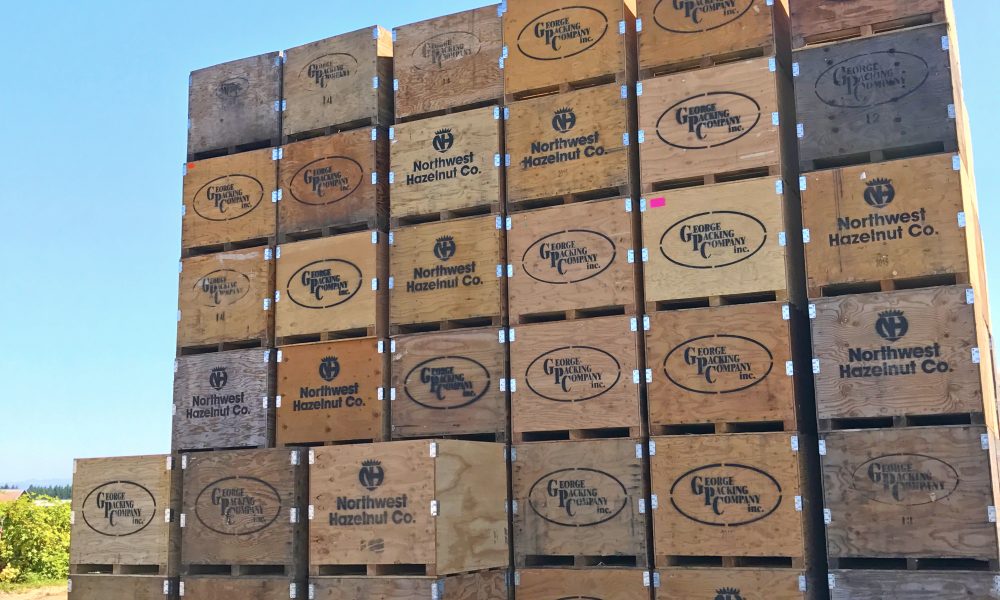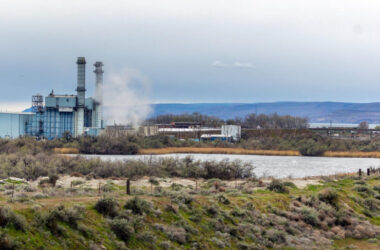 Hazelnuts are just one Oregon export impacted by increased tariffs from a trade war with China. (Oregon Department of Agriculture Flickr)
Hazelnuts are just one Oregon export impacted by increased tariffs from a trade war with China. (Oregon Department of Agriculture Flickr)
As the U.S. and China go tit-for-tat in an escalating trade war started by President Donald Trump, Oregon companies are caught in the fray.
Farmers who could previously depend on China to buy their products are left looking elsewhere for buyers as other countries supply the Chinese market. With Trump threatening to impose new tariffs, relief doesn’t appear to be in sight.
“This is a very serious issue, and the longer it goes on, the worse it’s going to get,” said Blake Rowe, CEO of the Oregon Wheat Growers League.
In July, Trump imposed new tariffs on $34 billion worth of Chinese goods, meaning many Chinese products will become 25% more expensive when they enter the U.S. In turn, China matched that by imposing tariffs on $34 billion of incoming American goods.
China is the U.S.’s largest supplier of goods, and makes up about 21 percent of all U.S. imports. The cost increase of those products is estimated to cost the average American household $600 per year. New tariffs, set to go into effect Dec. 15, would raise that to $1,000, according to an estimate released Tuesday by JPMorgan.
But there is also an indirect economic impact on the country as a whole, due to the direct hit from producers of goods traditionally exported to China.
[ Help build Malheur Enterprise and local news – SUBSCRIBE ]
According to Business Oregon, from March 2018 to May 2019, Oregon exports of wheat dropped by $55 million. Scrap metal also took huge hits, and soybeans took a $134 million loss. Few farmers grow soybeans in Oregon, so that figure can be a bit misleading, but they are shipped out of Oregon’s ports as they head to Asia, meaning the loss of product is still impactful.
According to the Port of Portland, wheat, soybeans and corn shipments are down by a combined 31% so far this year.
Port of Portland spokeswoman Susie Rantz said there is no easy way to determine the role of tariffs in declining exports, but the port has taken hits. It is one of the major western U.S. exporters for vehicles, with Ford being the main exporter to China, Rantz said.
Ford exports to China fell 40 percent in 2018 and another 15 percent so far this year.
State Economist Josh Lehner said data through June shows the dollar value of tariff-impacted goods to China hasn’t changed. He said there has been a surge in exports that don’t have increased tariffs, likely to get the goods out before a tariff is placed on them. But he said that data doesn’t tell the whole story.
“We know the impacts are larger than what is shown,” Lehner said.
Gail Greenman, director of national affairs for the Oregon Farm Bureau, said she hasn’t heard from farmers saying they are being seriously impacted by the tariffs, but it’s harvest season, the busiest time of year for agricultural producers.
“I don’t take that as an indication that this isn’t an issue for them,” she said.
Farmers of two of Oregon’s biggest agricultural products — wheat and hazelnuts — reported they are seeing impacts.
For Rowe, the impact on wheat exports is compounded by several trade policy decisions. Chinese buyers stopped buying Oregon wheat in 2018 after it was assumed the grain would be caught up in a trade war. Instead, they bought from Australia, Canada and Argentina, Rowe said.
However, he said Oregon producers found other buyers, and inventory has not yet built up. But the Chinese trade war, in connection with trade agreement changes with Japan and Mexico, have dropped the price of wheat by about $1 per bushel from where it should be, Rowe said. According to the wheat commission’s website, soft red winter wheat was valued at $4.71 per bushel on Aug. 16.
“It’s unfortunate that a lot of agricultural producers are caught in the crossfire,” he said.
Trump pulling out of the Trans-Pacific Partnership trade agreement allowed Australia and Canada to sell more wheat to Japan, he said.
“We are put at an ever-increasing competitive disadvantage,” Rowe said.
Under the North American Free Trade Agreement, wheat exports to Mexico had no tariffs. When Trump started talking about renegotiating that deal, Mexican buyers started looking at European suppliers, Rowe said.
In a business with razor-thin margins that depends on selling high quantities, that’s troublesome, he said.
“In the agricultural business, you never like to see your customers exploring other suppliers,” Rowe said.
Oregon’s state nut has also taken a hit.
Larry George, owner of the Northwest Hazelnut Company, said in some years 70% of Oregon hazelnuts are exported to China. Even prior to 2018, George said, there was a high tariff on the nuts but it was too small of a crop to garner the attention of the Chinese or U.S. government.
Now, the increased tariff means that when he ships his nuts to China, he has to pay a tariff equal to 82% of the price of his product.
But he sees relief on the horizon. The huge penalty has opened up conversations with both countries.
“We’re calling it short-term pain for long-term gain,” George said.
George said Oregon’s congressional delegation has been a huge help, especially U.S. Rep. Suzanne Bonamici. United States Trade Representative Robert Lighthizer even brought up hazelnuts in testimony to Congress, he said. He said after 20 years of high tariffs, the situation might actually get solved.
“We’re really hurt by the tariffs, but the whole entire trade discussion, for the long term, we have to have it,” George said.
Reporter Aubrey Wieber: [email protected], 503-575-1251




